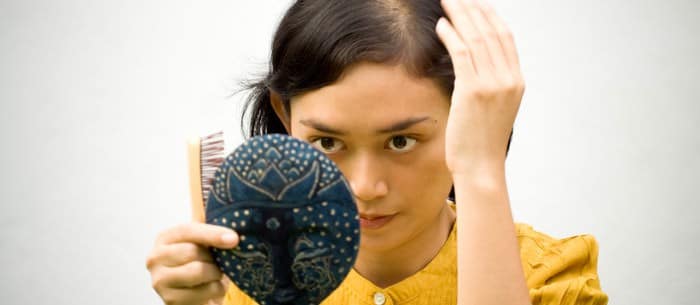When Kelly Kutchinsky of Philadelphia had her baby eight ago, she was told she’d likely start shedding her hair. “It didn’t happen right away, but in the last two months it has gotten ridiculous,” she says. “I seriously pull out handfuls of hair every morning and our shower has been clogged twice now in the past two months — and forget about the hair that is all over the sink, bathroom floor and my pillow!”
Kelly is definitely not alone. We’ve all seen the clump of hair in the drain, or the hairbrush full of our lovely strands. You might even have seen Joan Rivers touting thinning hair products on QVC. The truth is, one out of four women suffers from hair loss, yet very few of us want to talk about it (except for Joan, of course).
“Hair loss can be very traumatic for a woman,” says Dr. Debra Jaliman, a New York City-based dermatologist. “But it’s a common problem, and in the majority of cases it is treatable.”
“Most of us lose somewhere between 50 to 150 strands of hair every day, but a normal, healthy scalp will simply produce more hair to replace that loss,” says Dr. David Bank, president of the New York State Society for Dermatology and Dermatologic Surgery.
What to look for
According to Dr. Bank, a healthy scalp is typically when 80% of the hair follicles are in the growing stage, and 20% are in the resting stage (before it falls out and the follicle regenerates). “When that growing stage stops — or slows down considerably — is when people will notice hair thinning and loss,” he says. “Men tend to lose it in a pattern, receding from the forehead or the crown of the head, while women tend to lose their hair in more diffuse patterns. So they will notice an overall thinning of the hair at first as opposed to bald spots.”
This is where going to the same hair stylist has its advantages (even after she raised her price). “There are certain areas that are hard to see and a stylist will be able to notice, such as the top area behind the ear,” says Sherry Ratay, a hair stylist for 20 years and the owner of Salon Ratay in Orlando, Florida. “And a stylist that is familiar with your hair will be able to tell you if the texture has changed or if there is more hair coming out than usual while she’s blow drying and styling.”
If you notice the hair thinning in certain sections, or large clumps coming out, see a dermatologist immediately. Research shows that people suffering from hair loss often wait until 50% of their hair is gone before seeking treatment. “A doctor will do a complete medical history and blood work to try to diagnose the cause of the hair loss,” says Dr. Jaliman.
The causes
While many women suffer from genetic hair loss — including the possibility of the autoimmune disorder Alopecia, which affects approximately one in 50 people — there are non-genetic causes, too. They include:
Hormonal changes or imbalances. Pregnancy, childbirth, menopause or an underactive/overactive thyroid can all cause temporary hair loss. “Between 20 and 45 percent of mothers lose hair after giving birth as their estrogen and progesterone levels drop, and hair follicles are thrust into the inactive phase,” says Dr. Amy Wechsler, dermatologist and author of The Mind-Beauty Connection. “Luckily, most mothers will regain their head of hair nine to twelve months after the child’s birth.” The same is true for other hormonal changes — once your body adjusts or the imbalance is restored (a thyroid issue can be treated with medication), the hair will begin to grow back.
Medications. Drugs to treat anything from gout and arthritis to diabetes and high blood pressure can cause hair loss in some people. “If that’s the case, there is almost always another option that won’t cause this problem,” says Dr. Jaliman. Starting or stopping birth control pills can also affect a woman’s hair growth.
Physical trauma. Surgery or even an extreme illness — such as a high fever, bad flu or pneumonia — can result in temporary hair loss.
Stress. Although it’s rare that everyday stresses can cause a woman to lose her hair, extreme stress, such as a death in the family, divorce, losing/starting a job, etc., can have an impact. “Stress can literally shock hair follicles into an inactive state, after which they will likely fall out,” says Dr. Wechsler. “Sudden stress-related hair loss is characterized by a general thinning throughout the entire scalp.”
Poor nutrition. Crash diets aren’t good for your health or your hair. Rapid weight loss plans, especially low-protein diets, can cause hair loss.
Excessive styling. Women do a lot of damage to their hair in the name of beauty: Coloring, straightening treatments, weaves and extensions can all cause the hair to become dry and brittle, resulting in strands or entire sections breaking off.
The solutions
First, see if you can get your hair healthy again with some simple lifestyle changes.
Take your vitamins. Biotin (Vitamin B7) has been shown to boost hair growth and strength. There are also special supplements on the market specifically designed for healthy hair (check with your doctor first). And since pregnant women often enjoy fuller hair while taking prenatal vitamins, feel free to stay on those even after you give birth!
Improve your diet. Make sure you eat plenty of nutritious foods to keep your hair healthy.
Figure out your hair texture. According to Ratay, how much washing, styling, and coloring your hair can handle depends on whether it’s fine, medium or coarse. Not sure? Ask your stylist.
Get a cut. If there is a great deal of breakage, you will probably need to cut or clip your hair, says hairstylist Toni Love author of “The World of Wigs, Weaves and Extensions.” Then you can focus on getting what you have left — and what’s to come — healthy and full.
Use a deep conditioner. You can go to the salon for a treatment or ask your stylist for some at-home options (she might even recommend you do both). “Just be sure that you don’t over condition the hair because it will become limp, weak, and won’t hold curls, eventually shedding a lot,” says Love.
Don’t dual process. Never color and perm or relax your hair on the same visit. “Your hair is a fabric, so it needs to be treated gently,” says Ratay.
Color wisely. Ammonia makes it easier for hair dye to seep into the hair, but it also strips hair of its natural nutrients, weakening the quality of the hair. Ask your salon if they have ammonia-free options.
Skip tight styles. Putting your hair in a tight ponytail, braids or a bun can cause breakage because the follicles of the hair are not being stimulated.
Only use clip-on extensions. If there is just some minor thinning of the hair, extensions could be an option for you — but make sure they’re clip-ons. You can take them out at night and they don’t put pressure on the scalp like the type that is braided into the hair. And they should not hurt. “If you’re not sure your stylist is doing what’s best for you and your hair, go to someone new,” advises Love.
If that doesn’t work, consult a doctor, who will probably discuss such treatments as:
Female Rogaine. “Rogaine Topical Solution and Rogaine Foam are both very effective to treat female pattern hair loss,” says Dr. Robert Leonard, founder and chief surgeon of Leonard Hair Transplant Associates. “It can stabilize hair shedding, as well as regrow hair.” An even more effective treatment has been found in coupling the Rogaine with Low Level Laser Light Therapy. “This is the newest treatment for female pattern baldness. It effectively decreases hair shedding and can regrow hair.”
Hair Replacement. Nope, not just for men! The Hair Club offers Bio-Matrix hair replacement solution, which is a strand-by-strand process of crisscrossing transparent fibers that are shaped to specifically fit the balding and thinning areas of your head. The stylists match the fibers to your hair’s texture, color and length, and even cut and style your hair when finished. “The procedure is so intricate that no one will be able to tell the difference between your natural hair and the fibers — even close up,” says Lee Zoppa, vice president of marketing and advertising.
There is also hair transplant surgery, which works for some — not all — women. “Hair transplantation has evolved over the years, producing much better results, a more natural look and fuller coverage,” says Zoppa. “Microscopic Follicular Unit Transplant is an advanced hair loss treatment procedure that produces more authentic looking results than other less precise, outdated procedures. As your hair grows naturally, it is transplanted from the back of the head to thinning areas in natural groupings of one to four hairs.”






